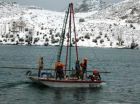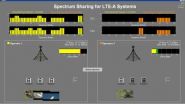Breastfeeding and lung function at school age: Does maternal asthma modify the effect?
2012-02-06
(Press-News.org) Breastfeeding is associated with improved lung function at school age, particularly in children of asthmatic mothers, according to a new study from researchers in Switzerland and the UK.
"In our cohort of school age children, breastfeeding was associated with modest improvement in forced mid-expiratory flow (FEF50) in our whole group and with improvements in forced vital capacity (FVC) and forced expiratory volume at 1 second (FEV1) only in the children of asthmatic mothers," said Claudia E. Kuehni, MD, MSc, professor at the Institute of Social and Preventive Medicine at the University of Bern. "In contrast, some earlier studies have suggested that breastfeeding might be harmful in the offspring of mothers with asthma."
The findings were published online ahead of print publication in the American Thoracic Society's American Journal of Respiratory and Critical Care Medicine.
The researchers analyzed data from a nested sample of 1458 children from the Leicestershire cohort studies, born between 1993 and 1997 in the UK. They assessed duration of breastfeeding, other exposures and respiratorysymptoms by repeated questionnaires. Post-bronchodilator FVC, FEV1, peak expiratory flow rates (PEF), FEF50 and skinprick tests were measured at age 12.
In the entire sample of children, FEF50was significantly higher in breastfed children compared with those who were not breastfed, increasing by 0.130 L/sec (P=.048) in those breastfed for 4-6 months and 0.164 L/sec (P=.041) in those breastfed for more than six months. These effects were larger among children of mothers with asthma, with increases of 0.375 L/sec (P=.015) in those breastfed for 4-6 months and 0.468 L/sec (P=.009) in those breastfed for more than six months. Significant improvements in FVC and FEV1with breastfeeding were seen only in the children of asthmatic mothers. Adjustments for respiratory infections in infancy and asthma and atopy in childhood did not change the results of these analyses.
The study had several limitations, including a modest response rate of the original cohort for laboratory examinations and the use of self-report for determining duration of breastfeeding, maternal asthma and infections during infancy.
"We observed modest improvements in lung function in breastfed children in our cohort, including the children of mothers with asthma. Furthermore, our data suggest that rather than acting by reducing respiratory infections, asthma or allergy, breastfeeding might have a direct effect on lung growth," said Dr. Kuehni. "This study supports a strong recommendation for breastfeeding in all children, including those with asthmatic mothers."
INFORMATION:
About the American Journal of Respiratory and Critical Care Medicine:
With an impact factor of 10.191, the AJRRCM is a peer-reviewed journal published by the American Thoracic Society.It aims to publish the most innovative science and the highest quality reviews, practice guidelines and statements in the pulmonary, critical care and sleep-related fields.
Founded in 1905, the American Thoracic Society is the world's leading medical association dedicated to advancing pulmonary, critical care and sleep medicine. The Society's 15,000 members prevent and fight respiratory disease around the globe through research, education, patient care and advocacy.
END
ELSE PRESS RELEASES FROM THIS DATE:
2012-02-06
Most spiral galaxies in the Universe have a bar structure in their centre, and Hubble's image of NGC 1073 offers a particularly clear view of one of these. Galaxies' star-filled bars are thought to emerge as gravitational density waves funnel gas toward the galactic centre, supplying the material to create new stars. The transport of gas can also feed the supermassive black holes that lurk in the centres of almost every galaxy.
Some astronomers have suggested that the formation of a central bar-like structure might signal a spiral galaxy's passage from intense star-formation ...
2012-02-06
American scientists believe a new procedure to repair severed nerves could result in patients recovering in days or weeks, rather than months or years. The team used a cellular mechanism similar to that used by many invertebrates to repair damage to nerve axons. Their results are published today in the Journal of Neuroscience Research.
"We have developed a procedure which can repair severed nerves within minutes so that the behavior they control can be partially restored within days and often largely restored within two to four weeks," said Professor George Bittner from ...
2012-02-06
Johns Hopkins neurologists report success with a new means of getting rid of potentially lethal blood clots in the brain safely without cutting through easily damaged brain tissue or removing large pieces of skull. The minimally invasive treatment, they report, increased the number of patients with intracerebral hemorrhage (ICH) who could function independently by 10 to 15 percent six months following the procedure.
At the International Stroke Conference taking place January 31 through February 2 in New Orleans, the researchers will present their findings from 93 patients, ...
2012-02-06
Free-flowing cancer cells have been mapped with unprecedented accuracy in the bloodstream of patients with prostate, breast and pancreatic cancer, using a brand new approach, in an attempt to assess and control the disease as it spreads in real time through the body, and solve the problem of predicting response and resistance to therapies.
In comparison to a previous generation of systems, the researchers state their test showed a significantly greater number of high-definition circulating tumour cells (HD-CTCs), in a higher proportion of patients, by using a computing-intensive ...
2012-02-06
Lost in the euphoria of the 2003 announcement that the human genome had been sequenced was a fundamental question: how can we be sure that an individual's genome has been read correctly?
While the first full, individual genome was sequenced a decade ago, given the vast genetic variation across the world's seven billion people, not to mention the differences in makeup even among close relatives, the question of accurate sequencing for individuals has continued to vex researchers.
With companies now projecting they can sequence a genome for a $1,000, down from $25,000 ...
2012-02-06
Nearly all organisms contain pieces of DNA that do not really belong to them. These "transposable elements", so called because they are capable of moving around within and between genomes, generally represent a drain on the host's resources and in certain cases may lead directly to disease, e.g. when they insert themselves within an essential host gene. The factors that govern the spread of transposable elements within a population are broadly understood but many of the finer points remain unclear. New work at the University of Veterinary Medicine, Vienna (Vetmeduni ...
2012-02-06
A team of Spanish researchers have used different geological samples, extracted from the Enol lake in Asturias, to show that the Holocene, a period that started 11,600 years ago, did not have a climate as stable as was believed.
The Holocene period, which includes the last 11,600 years of our history, has always been described as a stable period in terms of climatic conditions, especially when compared to the abrupt changes that occurred in the last ice age, which ended around 10,000 years ago, giving way to the Holocene.
A study carried out by researchers from the Pyrenean ...
2012-02-06
Smartphones and tablets are some of the big sellers of the past year. Mobile Internet usage has increased rapidly with the sales success: according to a study of the industry association VATM, in 2011 the average data volume per mobile Internet user increased by 82 percent in Germany. In contrast to its predecessor UMTS, with the new LTE mobile radio standard, the clearly higher data rates and the shorter signal transmission times, providers want to cover the expected traffic. That is why the expansion of the LTE network is being pursued aggressively. Providers are setting ...
2012-02-06
London, UK – A new editorial released this week offers clarity and structure on confusing drug and alcohol addiction terminology for prescribers, users and regulators. "Through a glass darkly: can we improve clarity about mechanism and aims of medications in drug and alcohol treatments?" is published in the Journal of Psychopharmacology, the official journal of the British Association for Psychopharmacology, published by SAGE.
David Nutt and Anne Lingford-Hughes of Imperial College London's Neuropsychopharmacology Unit together with Jonathan Chick from Queen Margaret ...
2012-02-06
If you wanted to draw your family tree, you could start by searching for people who share your surname. Cells, of course, don't have surnames, but scientists at the European Molecular Biology Laboratory (EMBL) in Heidelberg, Germany, have found that genetic switches called enhancers, and the molecules that activate those switches – transcription factors – can be used in a similar way, as clues to a cell's developmental history. The study, published today in Cell, also unveils a new model for how enhancers function.
Looking at fruit fly embryos, Guillaume Junion and Mikhail ...
LAST 30 PRESS RELEASES:
[Press-News.org] Breastfeeding and lung function at school age: Does maternal asthma modify the effect?



